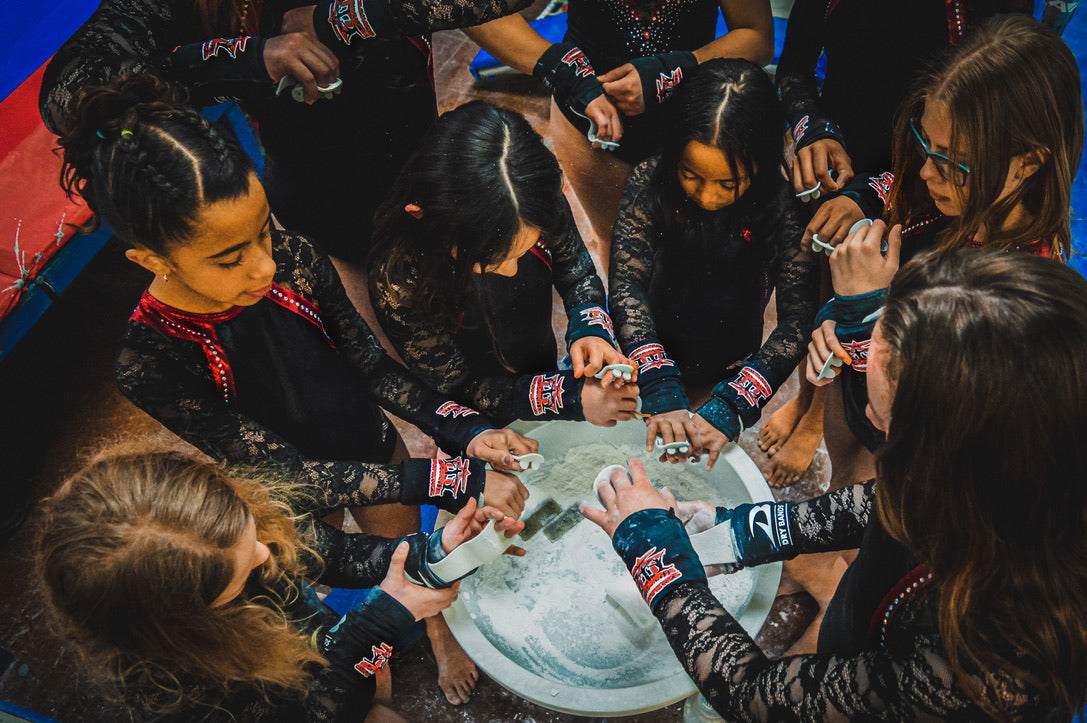Why do BARS cause RIPS? And how to FIX it!
By: Jen Dodson
Edited by: Mandy Welch
Have you ever wondered why you get blisters and rips after a long day of bars?
What causes those nasty, painful little sores that sting so much and make washing your hair nearly impossible?
Why do your wrists also frequently end up red and sore?
More importantly, what can be done to PREVENT THIS from happening
in the FUTURE?
Let's start at the beginning and clear up some common misconceptions.
*FUN FACT: The fourth layer of the epidermis (the layer of skin that you can see) gives your skin strength and flexibility. This is where blisters actually form.
BUT why DID I GET A BLISTER?
When your hands swing around the bar, a shear force is created between the upper and lower layers of your skin. Shear means that the layers are being pulled in opposite directions, similar to tearing a piece of paper in half. The top layer of skin is sliding in one direction with the bar, while the layers beneath are being pulled in the opposite direction with your bones. Sometimes, the shear force is great enough to tear the layers of skin apart, leaving behind a small gap.
*FUN FACT: Scissors are sometimes called shears. Their blades slide past each other in opposite directions.
The gap left behind fills with clear fluid to cushion and heal the tissue underneath. This fluid is called plasma, which is basically your blood without the red blood cells. It is mostly made up of water. Sometimes, if blood vessels in the skin are also broken, blood fills your blister. A blood blister looks a lot scarier, but is not a cause for concern.
However, if your blister is ever filled with yellow or white pus, it is likely infected and should be checked out by a physician!
*FUN FACT: Blisters are caused from the shear force created between layers of your skin, NOT the friction between your skin and the bar!
SHOULD I pop IT?
NO!! The plasma underneath is working to heal the tear between the layers of skin. Popping the blister drains this fluid which slows down the healing process. It also creates a hole that can allow bacteria to get inside, which can lead to an infection. Blisters usually take 3-7 days to heal.
*FUN FACT: You may be unaware that you have a blister because blisters take up to 2 hours to completely fill with fluid!
WHAT exactly IS A RIP?
In medical terminology, a rip is a “deroofed” blister. It is kind of like removing the roof from a house. It is when the top is literally ripped off of a blister exposing the skin beneath. GROSS HUH!! During a bars workout, the top layers of your skin may tear away from the lower layers creating a blister. However, this often occurs without your knowledge since it can take up to two hours for the blister to fill with fluid and become recognizable. Often before it is filled with fluid, the friction between the bar and your skin causes the newly loosened top layers to tear off.
*FUN FACT: Typically, when you get a rip, the top 3 layers of the epidermis are torn off.
HOW TO care FOR A RIP?
When you get a rip, the best thing to do is to stop swinging bars for a few days and take action to start helping the rip to heal by doing the following:
-Wash the rip well with antibacterial soap. It will sting a lot, but this step is very important so don't skip it!
-Carefully cut off any dead skin that may be still attached with small scissors or nail clippers.
-Apply an antibiotic ointment such as Neosporin to help with the pain and to keep it clean.
-Cover it with a bandage.
-Tape the bandage to your hand horizontally if you are finished with bars, or vertically if you are going to continue bars.
Here is a helpful video on how to make a tape grip.
Check this video out for some further great advice on how to care for a new rip.
HOW TO heal YOUR RIP FASTER!:
- Use a product such as Rip Stopper Balm. This can help prevent rips as well!
- Use Vitamin E tablets (break them open and apply directly to the healing rip)
- Apply tea bags. (After making a cup of tea, put the tea bag in the refrigerator. When they are cool, you can then apply the tea bag directly to the rip for approximately 15-20 minutes. Tea contains tanic acid which will help soothe the pain and encourage new skin growth.)
WHY DO MY wrists GET SO SORE?
Your wrists are red and raw from a slightly different issue- chafing. Chafing is the friction between the actual wristband and the surface of your skin. It causes skin to look red and raw and you might have a painful stinging sensation as if your skin was burned or scraped. One of the main causes of chafing is moisture or sweat. Sweat also softens/weakens the skin which makes it more vulnerable to shear forces- the kind that cause blisters and rips.
Gymnasts typically use chalk (magnesium carbonate) to absorb the sweat, but it is nearly impossible to continuously apply chalk beneath the wristbands under your grips. This is why many gymnasts have painful burns on their wrists caused by a combination of the friction and moisture.
HOW CAN I prevent CHAFING
Athletes should always avoid cotton clothing or wristbands. Cotton soaks up sweat and stays wet for a long time, which creates the most chafing. Cotton is also a good insulator, meaning it keeps the heat in well. More heat equals more sweat, which makes the chafing worse.
*FUN FACT: The heat from working out does not directly cause the skin to burn.
Instead, it creates more sweat, which creates more friction.
It is the friction that actually damages the skin.
Taping the wrists prior to putting on wristbands and grips is a common technique in gymnastics. The tape creates a barrier between the skin and the wristbands in order to lessen the friction against the skin. However, this method does nothing to solve the moisture problem that sweating creates.
Synthetic fabrics, such as polyester and rayon, are made specifically for pulling the sweat away from an athlete's skin and are great at keeping it dry. These fabrics are also smoother and will produce less friction than cotton. As an added benefit, many have antimicrobial properties to decrease the amount of bacteria as well.
If you are having trouble with chafing or rips on your wrists, you may want to give DRY BANDS a try. They are great at pulling the moisture away from your wrists no matter how much you sweat and are a much healthier, less wasteful and faster alternative to tape and pre-wrap.
HOW TO prevent RIPS?
One thing that you can do to prevent rips that most people overlook, is to check your grip on the bar. If you are holding the bar too tightly, you are increasing the shear force which causes blisters and rips.
1. Relax your grip.
Gymnasts tend to grip the bar more tightly when they are nervous or are working a skill that scares them. Practicing mental relaxation techniques before meets and working on frightening skills on the strap bar or with a spot until you are more confident are two ways to help alleviate this issue.
2. Keep callouses filed down.
Another important prevention technique is to gently file down any callouses you get. The bigger the callous, the more chance it has of tearing off. You can do this with a pumice stone.
3. Don't pinch your palm.
If you are hanging without grips, like for conditioning, use this technique. Press up slightly and hang mostly by your fingers. (As opposed to sliding your hand down, like you do when you are wearing grips, and pinching your palm.)










Leave a comment